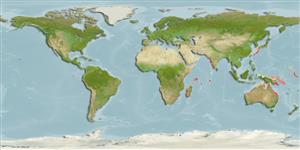Teleostei (teleosts) >
Perciformes/Uranoscopoidei (Sand dwellers) >
Ammodytidae (Sand lances)
Etymology: Ammodytoides: Greek, ammos = sand + Greek, dytes = anyone that likes immersions, diving (Ref. 45335).
Eponymy: Master John Rennie of Grahamstown, South Africa, discovered three specimens of this fish “found on the beach after an onset of cold water”. We assume the use of the term ‘Master’ implies that John was a boy when he made this discovery. (Ref. 128868), visit book page.
More on author: Smith.
Environment: milieu / climate zone / depth range / distribution range
Ecology
Marine; reef-associated. Tropical
Southeast Atlantic: East London to Port Alfred, South Africa. Western Indian Ocean: Seychelles (Ref. 5465). Western Central Pacific (Ref. 10275).
Size / Weight / Age
Maturity: Lm ? range ? - ? cm
Max length : 7.3 cm TL male/unsexed; (Ref. 5465)
Occurs in sandy areas (Ref. 10275). Rare species (Ref. 5465).
Life cycle and mating behavior
Maturity | Reproduction | Spawning | Eggs | Fecundity | Larvae
Collette, B.B., 2001. Ammodytidae. Sandlances. p. 3518. In K.E. Carpenter and V. Niem (eds.) FAO species identification guide for fishery purposes. The living marine resources of the Western Central Pacific. Vol. 6. Bony fishes part 4 (Labridae to Latimeriidae), estuarine crocodiles. FAO, Rome. (Ref. 10275)
IUCN Red List Status (Ref. 130435: Version 2024-1)
Threat to humans
Harmless
Human uses
Tools
Special reports
Download XML
Internet sources
Estimates based on models
Preferred temperature (Ref.
123201): 21.6 - 29, mean 27.1 °C (based on 1021 cells).
Phylogenetic diversity index (Ref.
82804): PD
50 = 0.5010 [Uniqueness, from 0.5 = low to 2.0 = high].
Bayesian length-weight: a=0.00324 (0.00140 - 0.00746), b=3.07 (2.88 - 3.26), in cm total length, based on LWR estimates for this (Sub)family-body shape (Ref.
93245).
Trophic level (Ref.
69278): 3.1 ±0.4 se; based on size and trophs of closest relatives
Resilience (Ref.
120179): High, minimum population doubling time less than 15 months (Preliminary K or Fecundity.).
Fishing Vulnerability (Ref.
59153): Low vulnerability (10 of 100).
